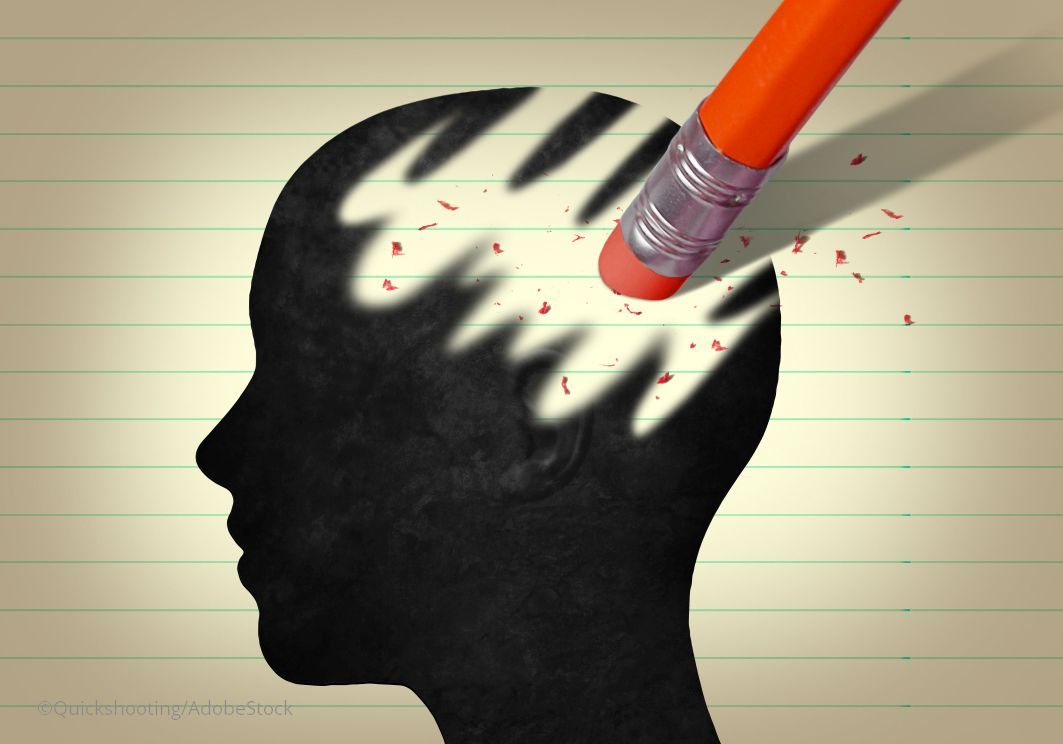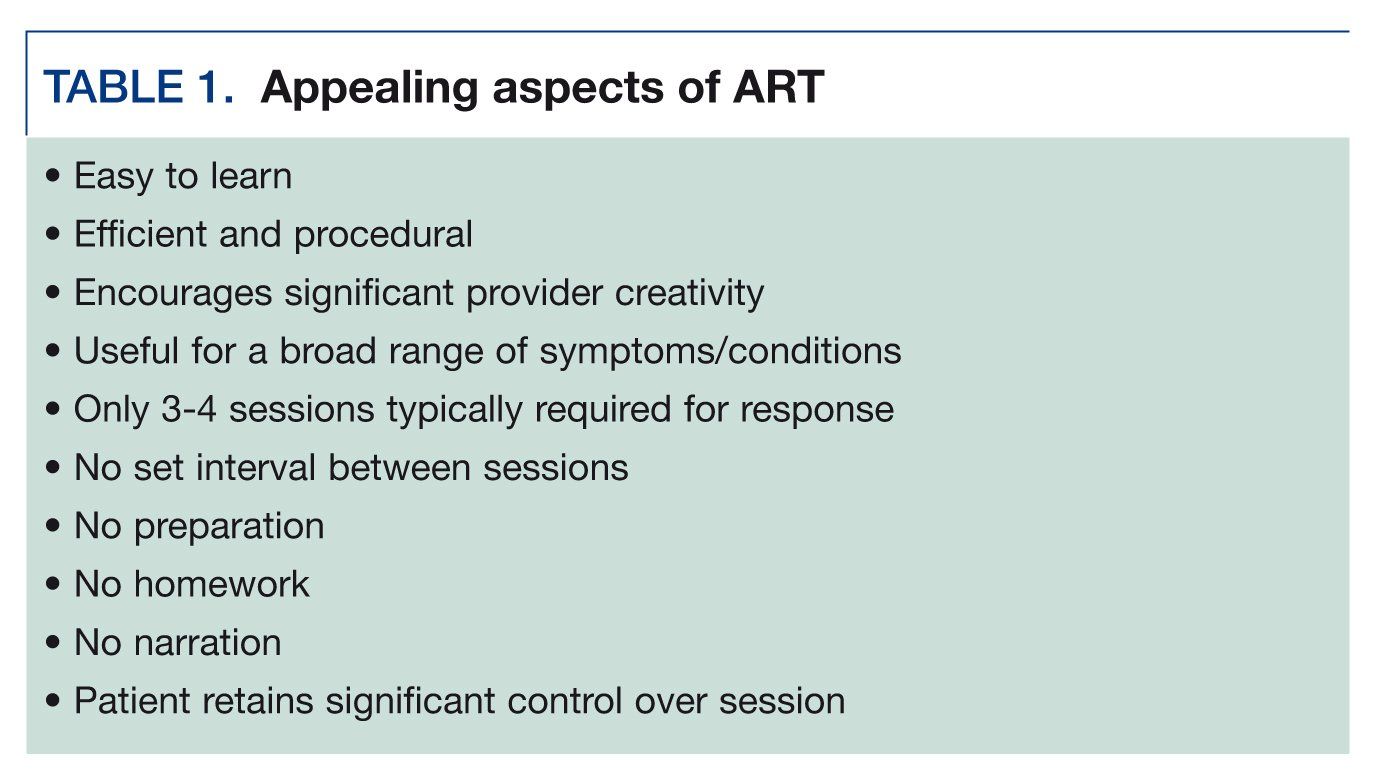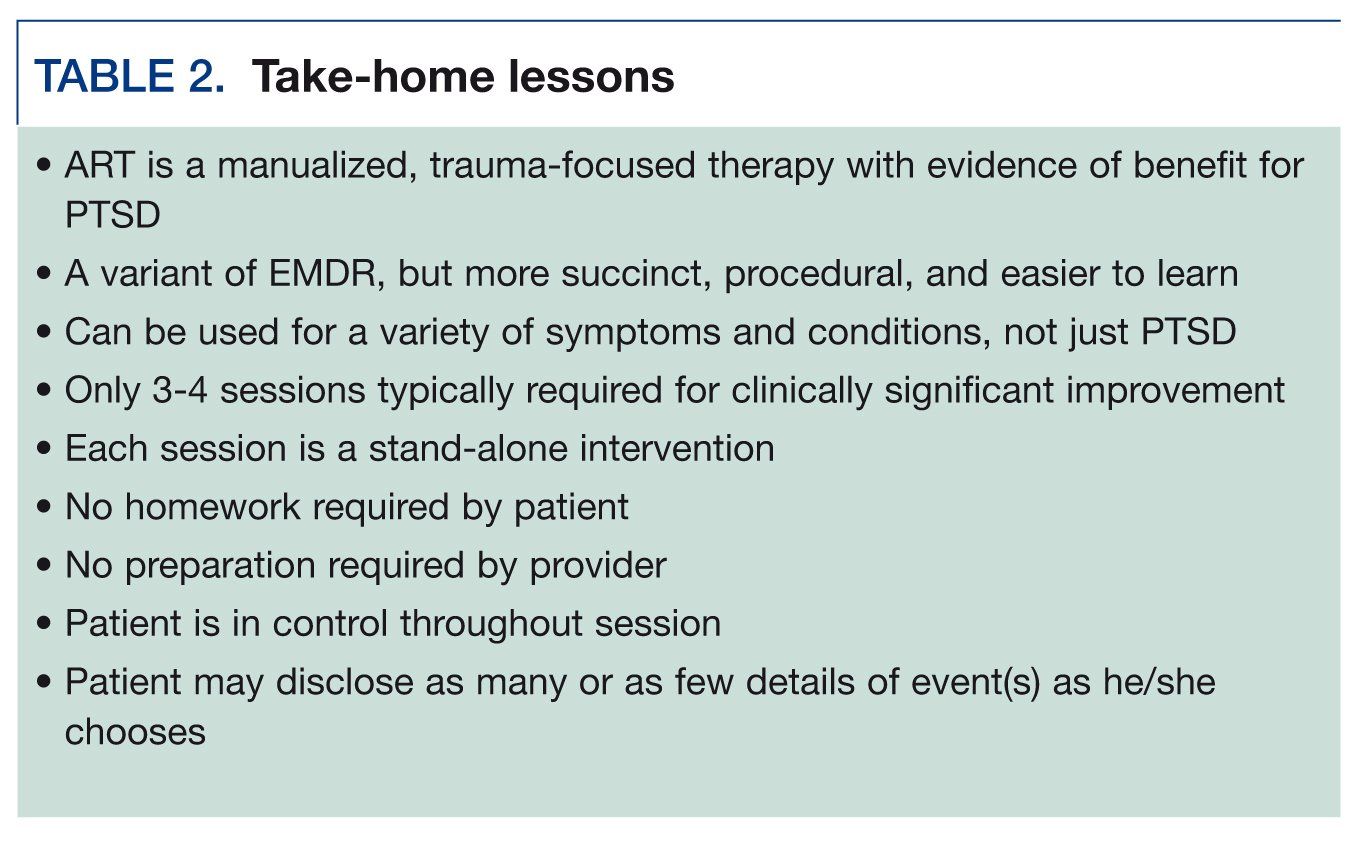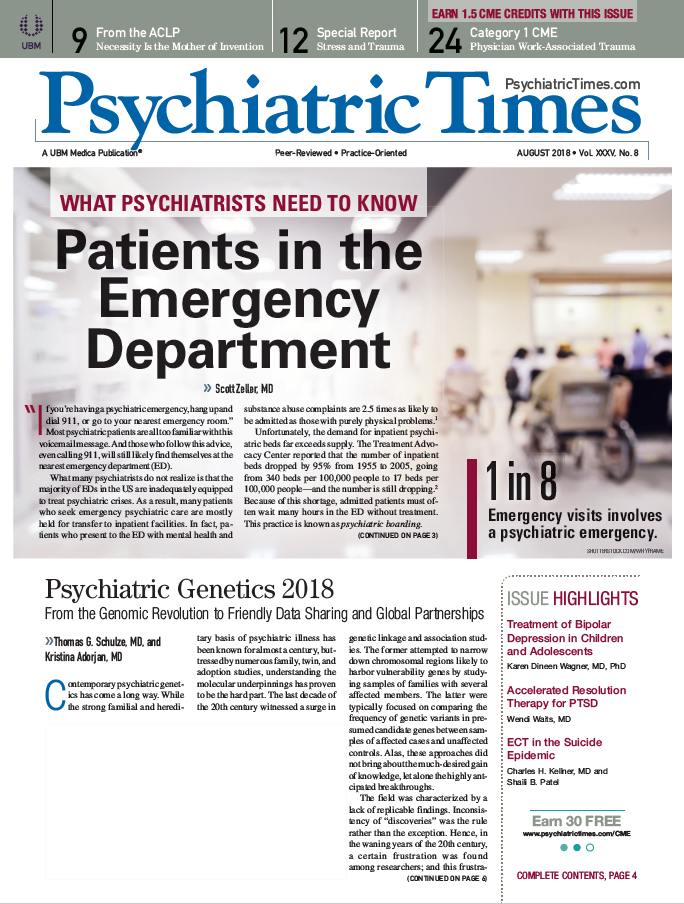Publication
Article
Psychiatric Times
Accelerated Resolution Therapy for PTSD
Author(s):
ART can be used in conjunction with other trauma-focused therapies. This article discusses the clinical utility of ART, as well as the research behind it.

TABLE 1. Appealing aspects of ART

TABLE 2. Take-home lessons

Accelerated Resolution Therapy (ART) is an emerging, efficient therapy for PTSD and other psychiatric conditions. It is derived from Eye-Movement Desensitization and Reprocessing (EMDR), but it has a tighter protocol, is more directive, more procedural, and easier to learn. (See Kip et al.1; for a general description of the proprietary ART protocol.) ART has been reported to be effective, efficient, easy on patients, and easy on clinicians.2;
Research
Unlike psychotherapies developed in university or research environments, the ART protocol was created by an experienced masters-level practitioner in private practice.³ For this reason, ART has not had as much research-based validation as EMDR, Prolonged Exposure, and Cognitive Processing Therapy (CPT). There have been three major clinical trials on ART for PTSD, only one of which involved a control group.4-6
Despite consistently showing impressive results, data from these trials must be interpreted with caution. All three studies were conducted by the same research team out of the University of South Florida, all three relied on patient self-report for outcome measurement, and only one study included a control group. A larger, high-quality randomized controlled trial comparing ART to CPT is currently underway at the Cincinnati Veteran’s Affairs (VA) hospital, although published data from this trial are not expected until 2019 or later.7 Nonetheless, against the backdrop of our current PTSD gold standard treatments, which have demonstrated high dropout rates, low remission rates, and low rates of provider use after training, ART at least seems worthy of a look.
In the ART randomized controlled trial, veterans or active duty service members were randomized to receive up to five sessions of ART or two sessions with a fitness coach or a career counselor. Using an intent-to-treat (ITT) analysis, ART demonstrated a 61% response rate (defined as at least a 10-point drop on the PTSD Checklist [PCL]) and a 94% completion rate.5 These are impressive results, given that established PTSD therapies have a response rate of 49% to 70% and a completion rate of only 60% to 65%.8,9 Furthermore, the number of ART sessions needed in this trial was 3.7 ± 1.1. This number is significant not only because it is fewer than the 8 to 15 sessions required by traditional evidence-based therapies for PTSD, but because up to 83% of patients who drop out of these treatments do so before their fifth session.
Theory
The key to ART’s efficiency is believed to lie in its exploitation of natural memory consolidation mechanisms. Memories undergo minor modifications every time we recall them, and that memory activation is critical to effective PTSD therapy.10,11 There is evidence to suggest that activating a memory, changing its emotional valence by introducing a novel sensation or stimulus during activation, and reconsolidating it (“putting it away”) within a discrete period of time can modify memory traces at the level of DNA transcription, essentially locking in the changes in a permanent manner.¹² This period of time, or “reconsolidation window,” is believed to be 1 to 6 hours in humans.
Like other reconsolidation therapies, the ART protocol not only extinguishes the patient’s fear response, but it also unwires distressing emotions from the factual memories of the events that created them. Said another way, reconsolidation therapies “fulfill the brain’s requirements for allowing new learning to rewrite and erase an old, unwanted learning-and not merely suppress and compete against the old learning.”13
Clinical application
In many ways, ART may be easier to integrate into psychiatric practice than traditional PTSD therapies (Table 1). Each ART session is a stand-alone intervention and the time between sessions is not prescribed. ART can also be used in conjunction with other trauma-focused therapies. For example, ART may be a useful adjunct when a patient arrives too distracted by a competing problem to engage in the planned session, when he or she is highly emotional, is unable to speak, is working on an especially emotional aspect of trauma, or will not be able to easily do homework before their next traditional psychotherapy session.
A patient can return for the next ART session in one week or six weeks, and will generally not lose gains made in the interim. This may make ART an appealing option for patients who travel frequently, have busy work schedules, have significant child/elder care duties, or who have to travel long distances for their appointments.
Individual ART sessions do require time, however. An experienced ART patient can often complete a session in 50 to 60 minutes, but providers should allocate 90 to 120 minutes for initial sessions. Many providers have found that scheduling their new ART patients at the end of the workday provides them with the greatest flexibility and success.
Managing the patient’s expectations about ART is critical, perhaps because ART is so different than traditional psychotherapies; an unmotivated patient should not be offered ART.
There are several essential points to cover as part of informed consent for ART:
• ART uses eye movements.
• It is not hypnosis.
• It involves little talking.
• There is no homework.
• It requires a 10- to 15-minute mental review of painful life experiences.
• The patient may share as much or as little of these experiences as he or she chooses.
• It allows the patient to choose and replace negative images with positive ones.
• Patients will retain the facts of the events they process, potentially even remembering more details than before starting ART.
At my previous institution, with more than 50 ART-trained providers working in 10 different treatment settings, we saw many models of implementation. For new referrals, our most successful model involved the establishment of an ART clinic. Each referred patient was required to read a brochure, sign a form acknowledging each element of informed consent, and schedule the first 4 appointments. This model worked well because expectations were clear from the beginning and patients were less connected to their therapist (and thus less likely to request continued treatment).
Patients treated with ART by their established providers tend to be more challenging. They can drift into the rhythm of their pre-ART sessions, adding excessive detail, becoming tangential, resisting change, etc. This can sometimes make sessions less efficient and clinical outcomes less dramatic. However, even if a patient does not achieve remission from PTSD, ART may still significantly catalyze non-ART therapies, move patients past “stuck points,” and enhance insight. My established patients have made empowering life changes, decreased their reliance on medications, and decreased their frequency of appointments after several
CASE VIGNETTES
A 44-year-old male soldier with severe combat-related PTSD was referred to the ART clinic by his treating psychiatrist due to lack of response to medications. He received four ART sessions over the course of 5 weeks. His pre-ART PCL score was 72 and dropped to 55 after two sessions, during which he had processed a combat-related event and an intense argument with his wife. His score jumped to 77 just prior to his fourth session, in which he chose to process a childhood sexual assault. This was a challenging session, but it brought obvious relief. He moved from the area shortly thereafter and was lost to follow-up. We were able to reach him by email 5 months later, and he reported that he had weaned himself off of his meds, was divorcing his wife, and had surrounded himself with positive people. He completed a final PCL and his score was 26.
A 36-year-old male sailor with PTSD from various traumatic experiences as a mortuary affairs officer was in jeopardy of having his overseas orders cancelled because he was on psychotropic medications and required weekly psychotherapy appointments. After 8 months and 18 appointments of traditional behavioral health treatments, his PCL-5 score had only dropped from 54 to 46. His therapist referred him to the ART clinic and he completed three ART sessions in 4 weeks. His PCL-5 score at treatment completion was 10 and a month later it was 2. At that point, he told his therapist that “ART had changed everything.” He reported feeling “happy” and “proud,” had lost his fear of death, was drinking less, and had cut his cigarette use in half. More than a year and a half later, he is deployed overseas, no longer takes medications, and his health care utilization has significantly decreased. Whereas he had 36 documented medical appointments in the 16 months prior to ART, he has only had 3 documented appointments since completing ART.
Conclusion
Although its research base is still maturing, ART appears to be a promising and efficient intervention for PTSD and other psychiatric maladies (Table 2). Readers interested in being trained or who want to refer a patient to an ART therapist are directed to the Rosenzweig Center for Rapid Recovery (www.acceleratedresolutiontherapy.com) or ART International (www.artherapyinternational.org) for more information.
Disclaimer: The views expressed in this article are those of the author and do not reflect the official policy of the Department of the Army/Navy/Air Force, Department of Defense, or the US Government.
Disclosures:
Dr Waits is Clinical Associate Professor, Uniformed Services University of the Health Sciences and Director for Behavioral Health, Walter Reed National Military Medical Center, Bethesday, MD. The author has no conflicts of interest concerning the subject matter of this article.
References:
1. Kip KE, Shuman A, Hernandez DF, et al. Case report and theoretical description of accelerated resolution therapy (ART) for military-related post-traumatic stress disorder. Mil Med. 2014;179:31-37.
2. Waits W, Marumoto M, Weaver J. Accelerated resolution therapy (ART): a review and research to date. Curr Psychiatry Rep. 2017;19:18.
3. Rosenzweig, L. Personal Website. Psychology Today. www.psychologytoday.com/us/therapists/laney-rosenzweig-west-hartford-ct/36496. Accessed July 3, 2018.
4. Kip KE, Elk CA, Sullivan KL, et al. Brief treatment of symptoms of post-traumatic stress disorder (PTSD) by use of accelerated resolution therapy (ART). Behav Sci. 2012;2:115-134.
5. Kip KE, Rosenzweig L, Hernandez DF, et al. Randomized controlled trial of accelerated resolution therapy (ART) for symptoms of combat-related post-traumatic stress disorder (PTSD). Mil Med. 2013;178:1298-1309.
6. Kip KE, D’Aoust RF, Hernandez DF, et al. Evaluation of brief treatment of symptoms of psychological trauma among veterans residing in a homeless shelter by use of accelerated resolution therapy. Nurs Outlook. 2016;64:411-423.
7. Whitehurst C. Game-Changing PTSD Research Gets Greenlight Thanks to Major Donor: Chris T. Sullivan Foundation gives $1M to fund PTSD study at UC Gardner Neuroscience Institute. University of Cincinnati Foundation News & Events. https://foundation.uc.edu/05-news--events/press-releases/ucgni-sullivan-foundation. Accessed July 3, 2018.
8. Steenkamp MS, Litz BL, Hoge CW, Marmar CR. Psychotherapy for military-related PTSD, a review of randomized clinical trials. JAMA. 2015;314:489-500.
9. Gutner CA, Gallaghe MW, Baker AS, et al. Time course of treatment dropout in cognitive behavioral therapies for posttraumatic stress disorder. Psychol Trauma. 2016;8:115-121.
10. Redondo, Kim J, Arons AL, et al. Bidirectional switch of the valence associated with a hippocampal contextual memory engram. Nature. 2014;513:426-430.
11. Schnyder U, Ehlers A, Elbert T, et al. Psychotherapies for PTSD: what do they have in common? Eur J Psychotraumatol. 2015;6:1-10.
12. Schiller D, Monfils MH, Raio CM, et al. Preventing the return of fear in humans using reconsolidation update mechanisms. Nature. 2010;463:49-53.
13. Ecker B, Ticic R, Hulley L. Unlocking the Emotional Brain: Eliminating Symptoms at Their Roots Using Memory Reconsolidation. New York: Routledge; 2012.

Newsletter
Receive trusted psychiatric news, expert analysis, and clinical insights — subscribe today to support your practice and your patients.





